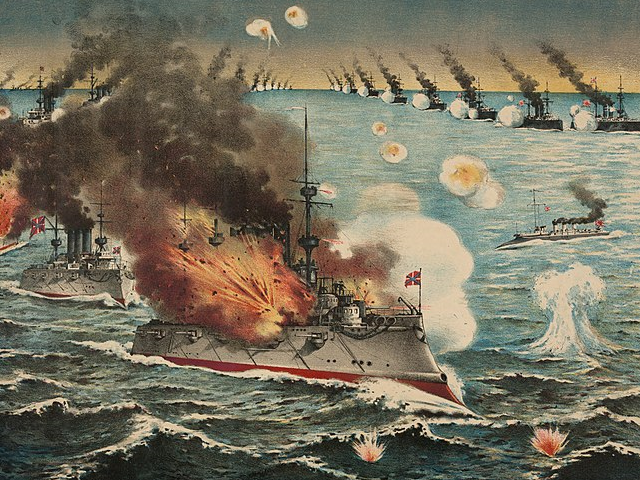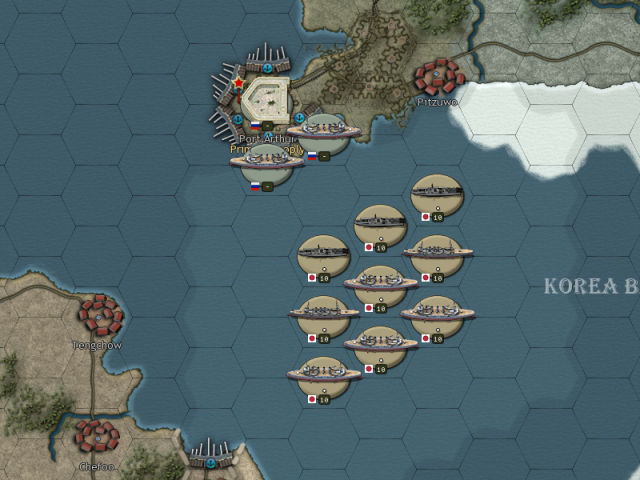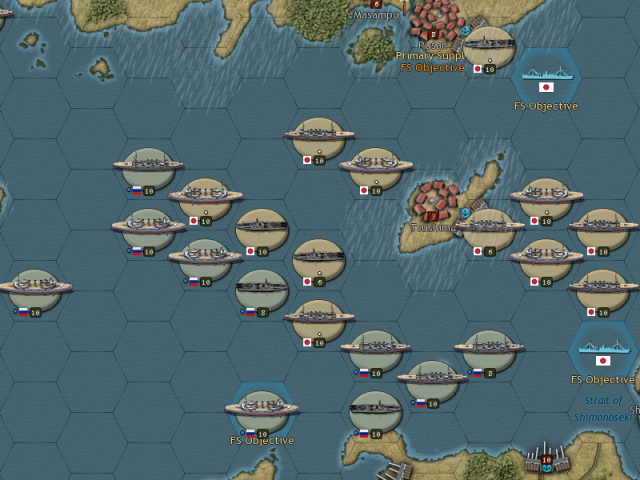On June 29th, we will be releasing the 1.08 patch for Strategic Command: American Civil War. In addition to the usual fixes and improvements, and as a way of celebrating the first anniversary of the game’s launch, this update also includes a brand new campaign, available for free to everyone who owns the game!
In this developer diary, we introduce 1904 Imperial Sunrise, covering the Russo-Japanese War.

Humbly reporting to YOUR IMPERIAL MAJESTY. Around midnight [February 8-9th], Japanese torpedo boats undertook a sudden attack on our squadron at Port Arthur base. The battleships Retvizan and Tsarevich and the cruiser Pallada have been ruptured; the degree of damage is being determined.
- Telegram from Viceroy Alekseyev to Tsar Nicholas II, on the first day of the war.
The story of the Russo-Japanese War began with Japan’s victory over China in 1895. In a war lasting a mere eight months, Japan had destroyed the Chinese Navy, asserted Japanese influence over Korea, conquered Formosa and captured Port Arthur, perhaps the finest harbour in the region. Yet the ink on the resultant Treaty of Shimonoseki had scarcely dried before Russia, with the support of France and Germany, pressured Japan to return Port Arthur to China in exchange for an enlarged war indemnity.
The Tsar, whose contempt for the Japanese dated back to an attempted assassination during an 1891 state visit to the country, had his own ambitions in the Far East. Within a few short years, Russia had deployed thousands of soldiers in Manchuria, established and fortified the naval base at Port Arthur, and was making moves to gain influence in Korea, causing alarm in Tokyo. When negotiations with St Petersburg stalled, the Japanese felt the only option left to them was war.

The Sun Rises
The campaign begins on the morning of February 9, 1904, and the Japanese player is immediately faced with decisions that will shape the outcome of the war.
In the Yellow Sea, Admiral Togo is stationed with the bulk of the Combined Fleet outside Port Arthur. The previous night, Japanese torpedo boats launched a surprise attack against the Russian Pacific Fleet, damaging several ships but sinking none, and the decision must now be made regarding a second strike: the Russian defences at Port Arthur are not yet fully prepared, and the damage suffered the previous night renders them vulnerable.
However, a more cautious approach may be worth considering instead. Port Arthur, located at the tip of the Liaodong Peninsula, is vulnerable to blockade by both land and sea. A sustained naval presence in the Yellow Sea, supported by naval mines, may be able to trap the Russian Navy in port without the need for an immediate, and costly, battle. Of course, this also risks the Russians attempting to fight their way out…

Japan’s greatest advantage lays in the preparations it has made before declaring war. Lessons learned from the war against China, and extensive training since, have provided Japanese units with a significant advantage in experience, while generous recruitment of local civilians in China and Korea will provide Japan with a generally favourable supply situation and regular intelligence updates.
Challenges of Deployment
With Tokyo having realised that further negotiations with the Tsar’s government would be fruitless by the end of 1903, the Imperial Army was mobilised and ready for battle. At the same time that Togo struck the Russian Fleet at Port Arthur, detachments of the IJA First Army were disembarking at Chemulpo, repeating a manoeuvre that had served them so well ten years prior.

These units, the 2nd and 12th Divisions, as well as General Kuroki’s headquarters, while sufficient to ensure the capitulation of the Korean government, represent merely the forward detachments for the Japanese land campaign. The rest of the Imperial Army begins the campaign still stationed on the Home Islands, and it will be up to you to manage their deployment in Korea and Manchuria, a task that will require you to navigate shortages of transport ships, frozen harbours (at least until the ice melts), and the constant threat of Russian cruisers.
Playing as Russia, you will need to plan the deployment of your forces carefully. While the Tsar’s army boasts more than a million soldiers (albeit lacking the quality of the Japanese army), these are deployed primarily in Europe and Central Asia, far from the likely battlefields of Manchuria. Russia’s industrial power dwarfs that of the Japanese, but the capacity of the Trans-Siberian Railroad limits the number of men that can be sent to the Far East.
Unlike Japan, Russia’s army (excepting the 100,000 men scattered across various small garrisons in the region) does not begin deployed on the map. Taking the place of Viceroy Alekseyev, you will need to request which units to send to the Far East via the Unit Purchase Screen. Sending these units will take time, forcing you to plan your battles several months in advance to ensure you have sufficient men on hand when the time comes.

A Race Against Time
No matter which side you choose to command, the calendar will be your enemy.
For Japan, the reasons for this are obvious. Going to war at all was a huge gamble by the leadership in Tokyo, as while Russia could count on nearly unlimited reserves of manpower, Japan meanwhile had virtually no reserves, and with less access to foreign markets than the Russians, it also risks financial collapse if the war drags on too long.
However, thanks to its pre-war preparations, Japan – provided the Imperial Navy can keep the supply routes to Korea open – can deploy its forces to the battlefield much more quickly than the Russians, providing them with a short-lived quantitative advantage. Japan therefore faces a dilemma: a rapid advance offers the best chance to deal a devastating blow to the Russian military before their numbers become too overwhelming, but this will result in heavier casualties that Japan can ill afford and will erode the quality of their units: quality that may well prove the difference in battles to come.

Russia too can scarcely afford delay. While in the long run the strength of the Russian Army in the Far East will grow to eclipse that of the Japanese, initially the Manchurian garrisons under Generals Zasulich and Kuropatkin will face an overwhelming advance, and merely 200 miles separate the Yalu River from Port Arthur, a distance the Japanese covered in just two months in 1894.
Furthermore, the prestige and reputation of the Tsar himself have been staked on the outcome of this war. No Asian nation has ever defeated a European power in a major conflict, placing enormous pressure on Russia to win a swift and decisive victory or risk great humiliation. With discontent growing against the Tsar’s autocratic regime, perhaps the Tsar’s interior minister said it best: “In order to prevent revolution, we need a little victorious war.”

Do You See the Torpedo Boats?
Success in this campaign will ultimately depend on your ability to achieve mastery both on land and at sea. With expectations of victory set so high by leaders in both Tokyo and St Petersburg, your nation’s Fighting Spirit will be rapidly eroded by even small reverses – the sinking of a battleship or the capture of a mere provincial city could be the difference between triumph and disaster.
Should the Imperial Navy fail to contain the Russian fleets in Port Arthur and Vladivostok, the Russians may be able to strike at Japan’s Fighting Spirit more directly, by imposing a blockade of Japan. By moving their warships, even for only a brief time, on or adjacent to any of the marked locations around the Japanese and Korean coastlines, Russia can disrupt Japanese trade and humiliate the Japanese Navy in a way that China never managed to in 1894. A sustained blockade may even doom the Japanese overland campaigns, as Russian warships cut the sea routes between the Home Islands and Korea, preventing the Imperial Army from receiving reinforcements.

Or will it be the greatest reinforcement of all that determines the outcome of the war?
The Russian Baltic Fleet is perhaps this conflict’s most remarkable chapter. Historically, the Baltic Fleet, or Second Pacific Squadron as it was officially called from mid-1904, embarked on an epic eight-month voyage halfway around the world (a journey both audacious and absurd), only to be destroyed in the Battle of Tsushima mere days before reaching their destination of Vladivostok. In the campaign, players will be provided notifications of the Baltic Fleet’s travels around the coasts of Europe and Africa, before the ships themselves deploy on the map in May 1905. Plan for it carefully, and the arrival of Rozhestvensky’s “miserable fleet” could be the decisive moment of the war!

“The Empire’s fate depends upon the outcome of this battle. Let everyone do his best”
- Admiral Togo, before the Battle of Tsushima.















